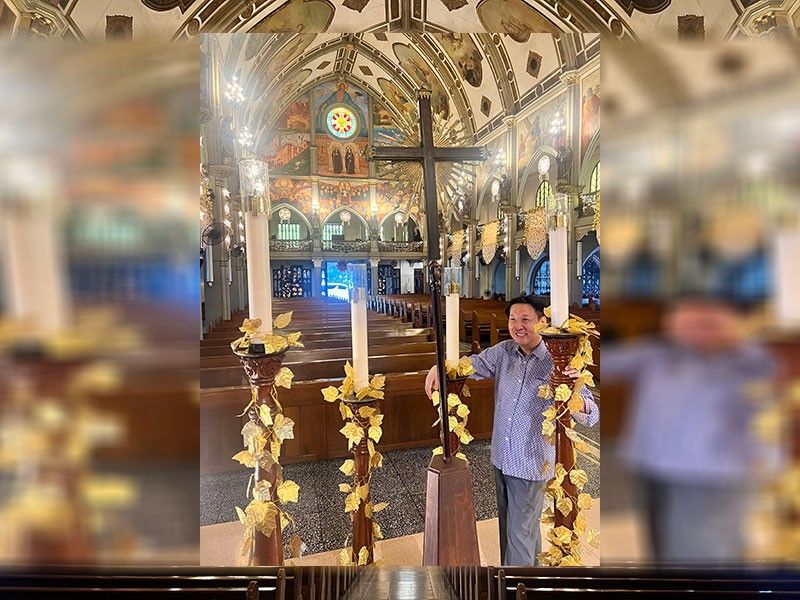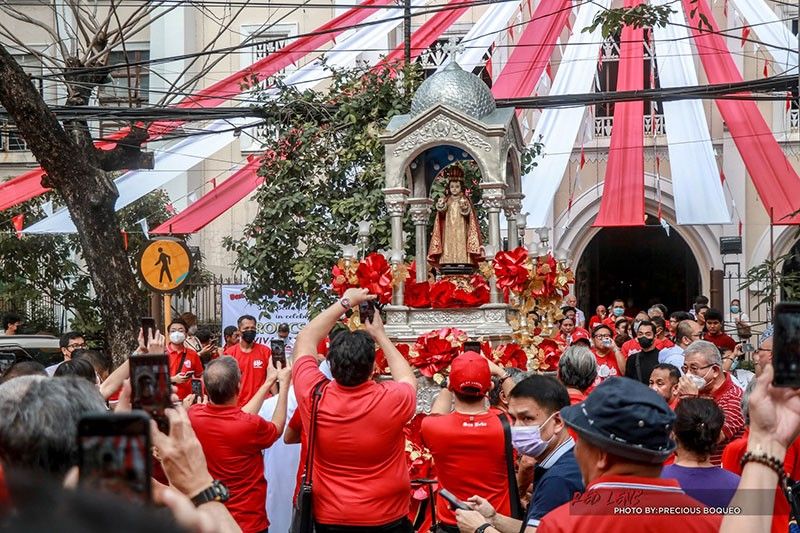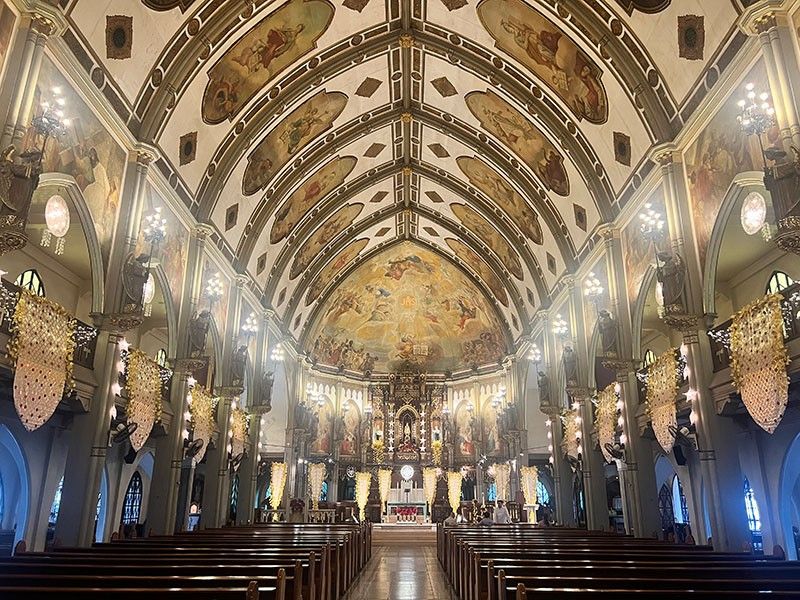The art of faith according to Rachy Cuna

Faith grows.
From one’s childlike wonder about the glory of God, one’s faith flourishes to become a vow. And when the vow is kept and shared, one’s faith is all the more fortified.
Rachy Cuna is known as the one and only floral architect of the Philippines. The least known fact about him is his devotion to the Sto. Niño—a devotion that has spanned more than 40 years. It is a vow he has kept to the Infant Jesus through his floral designs. With his art as his offering to the divine, he has found more meaning to his talent.
“Art is also faith,” Rachy says, the brevity of his thought belies the expanse of his faith.

Long before vegetables, fruits and even palay stalks, twigs and leaves became popular in tablescapes, Rachy has pioneered their use in his past floral installations for the Sto. Niño de Praga at San Beda University’s Abbey of Our Lady of Montserrat-Manila. A dyed-in-the-wool Bedan from grade school to college, Rachy has a four-decade tradition of decorating the altar of the abbey nine days before the school’s Pista ng Sto. Niño and Frolics, a much anticipated holy activity among students and alumni of the school.
On the day of the university’s celebration of the feast of the Infant Jesus, always on the last Sunday of January, he festoons the caroza of the Sto. Niño with blooms. Each flower is Rachy’s prayer of thanksgiving.
The playfulness of his design, many times, is attributed to Rachy’s constant dalliance with the child in him. Once, he filled the caroza of the Sto. Niño with teddy bears. “When we are in touch with the child in us, we become more creative. And it is my belief that it is our childlike personality that makes us deal with our faith with sincerity,” he says.
Rachy recalls that in the early ‘80s, Fr. Bobby Perez, then rector of San Beda College, asked him if he could decorate the abbey, the altar and the caroza of the Sto. Niño for the yearly festivity.

“I said yes right away. Naging panata (vow) ko na,” he says.
For Rachy, his yearly commitment to the Sto. Niño and the Bedan community is “a devotion of thanksgiving.”
“God has been good to me. I am humbled to fulfill my panata. I told the Lord, as long as You want me to decorate the abbey and the caroza, I will do it,” says Rachy, whose design this year of the holy place is rich with golden vines and tapestries of divinity.
“When Rachy decorates the Abbey Church and the caroza of the Sto. Niño during the fiesta, I see his design as an expression of his deep faith and devotion to the Sto. Niño. He is glorifying God in the beauty, simplicity and elegance of his works of art,” says Rt. Rev. Austin Cadiz, OSB, abbot of the Abbey of Our Lady of Montserrat-Manila.
He adds, “(When you admire Rachy’s work), a feeling of awe and wonder exudes. When people marvel at his wonderful works of art, God, who is the source of gifts and talents, is glorified.”
“Plain and simple, my yearly panata is to praise God,” Rachysays.
Fr. Abbot Austin recalls that when he was still a postulant in 1993, he and his friends would look forward to the yearly design of Rachy in the abbey.
“Every Pista, the Bedan community awaits the ‘drama’ that Rachy shares through his artistic floral arrangements and installations that made the Abbey Church and Sto. Niño caroza more beautiful,” says Joffre Alajar, executive director of the San Beda Alumni Office.
Joffre adds, “Rachy’s artistic touch and fondness for indigenous materials in the various installation and pieces he has created for San Beda always make for an unforgettable and remarkable Filipino celebration of Pista ng Sto. Niño.”
San Beda’s Fr. Maurus Cuachon says this year is the 130th year of the arrival of the Benedictine monks in the Philippines. The monks arrived in Manila on Sept. 12, 1895 to do mission work in Surigao. San Beda College was established in Manila in 1901. It became a university in 2018.
Why do many Filipinos have a special devotion to the Sto. Niño?
“From the time we received the Christian faith, we have been devoted to the Sto. Niño, the Child Jesus. As children of God, we look to the Sto. Niño for protection and guidance. Mindful of His teachings in the Gospel, we hope to follow the Father’s will in all aspects of our life. Our devotion then is our profession that to be great in the kingdom of heaven is to be like a child: simple, humble, and dependent on God,” says Fr. Abbot Austin.
The abbot also explains that the devotion to the Sto. Niño is an integral part of the life of every Bedan. “Since the early years of the school, students have been members of the Confraternity of the Infant Jesus of Prague. The Pista ng Sto. Niño, which culminates with the procession of the image of the Infant Jesus, is an important annual event in the Bedan community. It is a celebration of our Christian faith and the University’s mission of Bedan education to the youth.”
Fr. Abbot Austin says the Bedan community celebrates the Pista ng Sto. Niño as a family. It is a lively and solemn celebration of their thanksgiving to God for His love and theirlove for the Sto. Niño.
“It is a homecoming, where Bedans everywhere come to celebrate and reminisce our childhood days. That is why the fiesta celebration is also part of the yearly alumni homecoming celebrations,” Fr. Abbot Austin says.
He notes that the whole fiesta celebration as a homecoming “not only reconnects us with our friends, the Bedan family, and the Benedictine community. More importantly, it reconnects us with God and binds us together to our heavenly home.”
Fr. Abbot Austin explains that in the early years of San Beda, the students petitioned the establishment of a confraternity devoted to the Sto. Niño de Praga. Since that time, the procession on the streets surrounding Mendiola, where the school is located, featured that image of the Sto Nino.
“This is the reason why when San Beda needed an image, the Fathers decided to commission Maximo Vicente, a known sculptor in Quiapo, using a picture of the Sto. Niño de Praga enshrined in the church of the Salesian Sisters in Barcelona. Also, when the Abbey Church was dedicated in 1926, the Spanish monks of San Beda chose the Sto. Niño de Praga as co-titular with Our Lady of Montserrat. The image sculpted by Maximo Vicente was installed above the abbatial throne of the main altar. Since then, the Sto. Niño de Praga has become the image of the Child Jesus being celebrated traditionally in San Beda University,” Fr. Abbot Austin adds.
The monastic community of San Beda is a holy ground for Rachy where he exbibits his artistry.
“My art bears my faith. My yearly devotion to the Sto. Niño through the San Beda community will always find a place in my heart. It is a vow I will keep,” Rachy concludes. *
- Latest




























